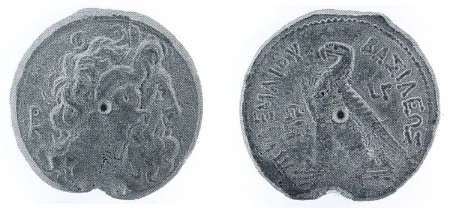S 107 - Alexandria, bronze, NC, 115/4-114/3 BC
From SILVER
114 BCE - 113 BCE Bronze
Description
| ObverseInscription or printing placed on the obverse.: | Head of Zeus Ammon right |
| ReverseInscription or printing placed on the reverse.: | ΒΑΣΙΛΕΩΣ ΠΤΟΛΕΜΑΙΟΥ (Greek).Eagle standing to left on thunderbolt, monogram in left field, date in right field |
Mint and issuing power
| MintIdentifies the place of manufacture or issue of a numismatic object.: | Alexandria | Ancient regionAncient region.: | Egypt | Modern countryModern country: Egypt | AuthorityIdentifies the issuing power. The authority can be "pretended" when the name or the portrait of X is on the coin but he/she was not the issuing power. It can also be "uncertain" when there is no mention of X on the coin but he/she was the issuing power according to the historical sources: | Cleopatra III of Egypt (Ptolemaic queen, 142-131 and 127-116 BC), Ptolemy IX Soter II (Ptolemaic king, 116-110, 109-107 and 88-81 BC) |
Chronology
| FromIdentifies the initial date in a range assigned in a numismatic context. | 114 BCE | toIdentifies the final date in a range assigned in a numismatic context.. | 113 BCE | PeriodTime period of the numismatic object.: Hellenistic 323-30 BC |
Physical description
| MetalThe physical material (usually metal) from which an object is made.: | Bronze |
Median weightMedian of the weights of numismatic objects (in grams). in grams | 16.00 | DenominationTerm indicating the value of a numismatic object. Examples: tetradrachm, chalkous, denarius.: | StandardStandard.: | Ptolemaic |
References
| Die study referencePublication of the study: | Faucher - Shahin 20061Faucher - Shahin 2006, p. 135-157, pl. 10-14. | ||
| Coin series referenceReference to coin series study: | |||
Obverse dies distribution
| FrequencyFrequency of specimen in distribution. ᵖ | Number of obversesNumber of obverse dies. ᵖ (o) | % (o) | Number of coinsNumber of coins. (n) | % (n) | Die nameName(s) of the die(s). |
| 1 | 13 | 46.43 | 13 | 20.63 | 6, 7, 8, 12, 14, 15, 16, 17, 18, 22, 25, 27, 28 |
| 2 | 6 | 21.43 | 12 | 19.05 | 5, 13, 21, 23, 24, 26 |
| 3 | 4 | 14.29 | 12 | 19.05 | 2, 9, 11, 20 |
| 4 | 2 | 7.14 | 8 | 12.7 | 1, 19 |
| 6 | 3 | 10.71 | 18 | 28.57 | 3, 4, 10 |
| Total | 28 of 28 | 100 | 63 of 63 | 100 |
Reverse dies distribution
no distribution is available
Quantification
| Number of obversesNumber of obverse dies. ᵖ (o) | 28 | Number of singletons (o1)The number of singleton coins. ᵖ | 13 |
| Number of reverse diesNumber of reverse dies. (r) | NC"NC" is not a number. | Number of coinsNumber of coins. (n) | 63 |
| Coins per obverse dieNumber of coins per obverse die. (n/o) | 2.25 | Coins per reverse dieNumber of coins per reverse die. (n/r) | |
| Reverse per obverse ratioRatio of obverse dies divided by reverse dies. (r/o) | Percentage of singletons (o1)number of coins (n) divided by the number of singletons (o1) ᵖ | 46.43 % | |
| Original number of dies (O) (Carter 1983 formula)The estimation of the number of coins according to Carter 1983 ᵖ | 41.64 | Coins struck if 20,000 as average productivity per dieCoins made if the average productivity for obverses (according to Carter) is 20,000. ᵖ | 832,800 |
| Original number of dies (O) (Esty 2011 formula)The estimation of the number of coins according to the singleton formula in Esty 2011 ᵖ (O) | 50.4 | Survival rate if 20,000 as average productivity per dieSurvival rate if average productivity is 20,000. ᵖ | 0.00008 |
| Coverage (o = % of O) (Esty 1984 formula)Esty 1984 - coverage (% of O) ᵖ (o = % of O) | 79.37% | Die productivity if survival rate 1/2,000Average productivity if survival rate is 1/2,000. ᵖ | 3,025.94 |
| Weight of silver (in kg) if 20,000 coins per die (O = Carter formula)Carter 1983 * Median weight * 20000 (*10 if gold or electrum) ᵖ | n.a. | Die productivity if survival rate 1/5,000Average productivity if survival rate is 1/5,000. ᵖ | 7,564.84 |
Remarks
References
- ^ Faucher, Thomas - Shahin, Mona (2006) "Le trésor de Gézéïr (lac Mariout, Alexandrie)", Revue Numismatique, p. 135-157, pl. 10-14.
